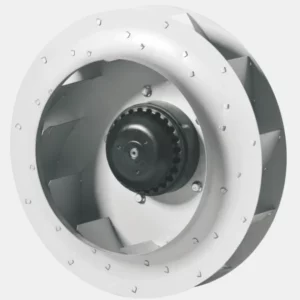Centrifugal fans are widely used in various industries and applications to move air or gases. Among the different types of centrifugal fans available, backward centrifugal fans stand out for their unique design and efficient airflow characteristics. In this article, we will explore the features, benefits, and applications of backward centrifugal fans.
Here is some information about rear-facing centrifugal fans:
Backward centrifugal fans, also known as backward curved fans, are characterized by their curved blades that tilt away from the direction of rotation. Unlike forward curved or radial fans, which have blades that curve towards the direction of rotation, backward centrifugal fans are designed to handle higher pressures and deliver greater airflow with reduced energy consumption.
Key Features and Benefits:
- High Efficiency: The backward curved blades of these fans are aerodynamically designed to maximize efficiency. The curved shape allows for smooth airflow and minimizes turbulence, resulting in improved performance and reduced energy consumption.
- Pressure Capability: Backward centrifugal fans are capable of generating higher static pressures compared to other fan types. This makes them suitable for applications that require air movement against resistance, such as in duct systems or equipment with restrictive airflow paths.
- Low Noise Levels: The design of backward centrifugal fans helps in reducing noise levels. The curved blades and smooth airflow minimize turbulence and air disturbances, resulting in quieter operation. This makes them ideal for applications where noise reduction is a priority, such as HVAC systems in residential or commercial buildings.
- Wide Operating Range: Backward centrifugal fans are versatile and can be used across a wide range of airflow and pressure requirements. Their performance can be adjusted by changing the fan speed or utilizing variable frequency drive (VFD) controls, allowing for precise airflow management in different conditions.
- Reliability and Durability: These fans are known for their robust construction and durability. The backward curved blades are typically made from materials like aluminum or composite materials, ensuring resistance to corrosion and wear. This results in longer fan life and reduced maintenance costs.
Applications of Backward Centrifugal Fans:
Backward centrifugal fans find application in various industries and systems, including:
- HVAC Systems: These fans are commonly used in heating, ventilation, and air conditioning (HVAC) systems for commercial buildings, hospitals, hotels, and industrial facilities. They efficiently move air through ducts, provide balanced ventilation, and contribute to temperature control and indoor air quality.
- Industrial Processes: Backward centrifugal fans are employed in industrial processes where high airflow and pressure capabilities are required. They are used for cooling equipment, controlling emissions, drying applications, and providing ventilation in manufacturing facilities, power plants, refineries, and more.
- Cleanroom Environments: Backward centrifugal fans play a vital role in cleanroom applications, where maintaining a controlled and contaminant-free environment is crucial. They ensure proper air circulation, air filtration, and pressure differentials to meet stringent cleanliness requirements.
- Data Centers: The efficient cooling of data centers is essential for optimal equipment performance and reliability. Backward centrifugal fans are employed in computer room air conditioning (CRAC) units and air handlers to provide precise cooling and maintain consistent airflow within server racks.
Backward centrifugal fans offer impressive airflow and pressure capabilities, along with energy efficiency and low noise levels. Their versatile design and durable construction make them suitable for a wide range of applications, including HVAC systems, backward centrifugal fan industrial processes, cleanrooms, and data centers. By choosing backward centrifugal fans, industries can benefit from efficient air movement, improved performance, and reduced energy consumption, contributing to enhanced productivity and environmental sustainability.
Characteristics of backward centrifugal fan
- Backward-curved blade design: The blades of backward-oriented centrifugal fans have a unique design compared to other types of fans. They are curved in the direction of departure from rotation, a design that allows the fan to handle higher pressures and deliver greater airflow with lower energy consumption.
- Energy saving benefits: Due to the efficient design of backward-facing centrifugal fans, they are able to provide the required airflow while reducing energy consumption. In contrast, a forward centrifugal fan or a radial fan may require higher energy to produce the same air flow.
- High static pressure capacity: The backward-facing centrifugal fan can cope with high static pressure requirements. This makes them suitable for applications where resistance needs to be overcome, such as piping systems or equipment with high air resistance.
- Quiet operation: The design of the backward-facing centrifugal fan helps to reduce noise levels. Curved blades and smooth airflow reduce turbulence and airflow interference, resulting in quieter fan operation. This makes them ideal for applications where noise levels need to be reduced, such as HVAC systems in residential or commercial buildings.
- Speed regulation and control: The performance of backward-facing centrifugal fans can be adjusted by changing the fan speed or using inverter control. This allows the user to precisely adjust the operation of the fan according to the actual demand, resulting in energy efficiency optimization and more precise airflow control.
- Various sizes and configurations: Backward-facing centrifugal fans are available in a variety of sizes and configurations. This means they can be adapted to different installation requirements and space constraints, from small equipment to large industrial systems.
- Reliability and durability: Backward-facing centrifugal fans usually have a robust construction and durability. The blades are generally made of aluminum or composite materials and are resistant to corrosion and wear. This makes the service life of the backward-facing centrifugal fan longer and reduces maintenance costs.
Backward-facing centrifugal fans are widely used in various fields because of their high efficiency airflow characteristics and energy saving advantages. They are suitable for a variety of applications, including HVAC systems, industrial processes, clean rooms and data centers. Choosing a backward-facing centrifugal fan can lead to efficient air movement, improved performance, and lower energy consumption, contributing to increased production efficiency and environmental sustainability.
